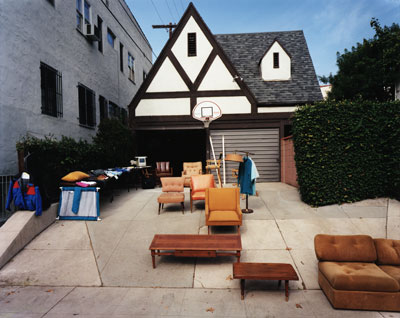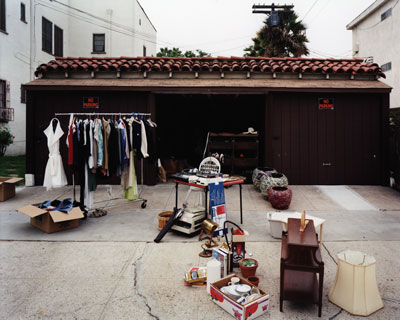
Karin Geiger: 633-D3, Los Angeles, 1998
During 1998/99 Karin Geiger undertook an extensive photographic documentation of garage sales in different parts of Los Angeles. The numbered title of each photograph refers to its location in the Thomas Guide, the city map that is used by everyone to navigate this suburban metropolis. Garage or yard sales have become an inescapable part of the weekend landscape in Los Angeles, springing up on Saturday mornings along otherwise uneventful residential streets. Ostensibly a way to sell an accumulation of unwanted consumer items that have ended up in the owner’s garage, it would be wrong to see them just as commercial ventures; they are also a kind of neighborhood event, and an opportunity for personal display. It is the display aspect that Geiger chooses to emphasize. There are no figures in the photographs: just the contents of the sale, arranged on the lawn, driveway, or sidewalk, with the house or apartment building in the background. It is the sale seen as a careful assemblage of objects, an early morning tableau to be seen from a passing car before it is disarranged by the arrival of the buyers.
Display is always an important part of the streetscape in Los Angeles. Houses can be in any number of architectural styles, applied over a wood-frame construction that remains essentially standard. Tudor sits happily next to Spanish or Moderne. Likewise the style of landscaping the yard in front of the house is quite arbitrary, as almost anything will grow here if given enough water; a desert garden can grow next to a tropical jungle or the traditional “English” lawn. The most important thing is the impression given to the passing motorist: the so-called “curb appeal,” to use a favorite term of the real estate market, that is nowhere as highly developed as in Los Angeles. The architecture and landscaping form a carefully considered composition that is intended to add to the property’s allure when seen from a passing car. Driving around becomes the Angelino equivalent of window-shopping.
Geiger chooses the document this same view from the street, but in her photographs the temporary event of the garage sale comes between the camera and its usual subject. The architecture and landscaping are still present, but take second place. The eye is drawn instead to a temporary display, the joyful range of artifice that people bring to the task of selling their belongings.

Karin Geiger: 593-C7, Los Angeles, 1998
As a commercial event inserted into a residential street, the garage sale is subtly subversive. Los Angeles is planned around a zoning code that aims to separate commercial and residential land use. However, the rigid structure created by the zoning is somewhat tempered by “the concrete diversity of a realistic order of things.” [1] For example, working at home is now part of everyday life in many neighborhoods, and the zoning code has recently been modified to permit something that is already a fact on the ground. Likewise, the garage sale is tolerated, as long as it does not take place too often. In the terms of de Certeau, it is an example of the tactics of the user subverting an imposed abstract ordering strategy, in this case the zoning code. [2] The required, but often unused set-back of the house from the street is adapted by the creative user into a kind of horizontal billboard.
Is the garage sale part of a gradual transformation of “everyday space” in Los Angeles? The architectural and urban theorist Margaret Crawford has recently raised this question. [3] While Crawford chooses to emphasize examples of garage sales that become semi-permanent events, such examples are generally confined to the poorest parts of the city. In more prosperous areas, where homeowners’ property values are at stake, it seems less likely that a permanent transformation is taking place: an occasional garage sale is allowed, as a temporary suspension of normality. In some areas the homeowner is required to get a permit from the city, and is limited to two sales per year. As the exception within the everyday, the garage sale bears some similarity to Lefebvre’s formulation of the festival as contrasting “violently with everyday life” but without being “separate from it.” [4]
The fascination of the Geiger’s photographs, however, goes beyond the temporary blurring of commercial and residential space. They describe a temporary transformation or inversion of normal everyday relationships between public and private space. Each photograph describes the normal defensive structure of suburban space, as seen from the street—sidewalk, fence, front lawn, driveway, garage, and house—and how this is transformed by a display of objects that are usually hidden from public view. Although one realizes that, with the exception of genuine moving sales, the objects are not the actual contents of the house, the photographs nonetheless give the impression that the sale is an exhibition of the private lives of the people who live in the house. There is a sense of seeing those things that the house is actually meant to protect from public view. This upsetting of the usual order of things—to often surreal effect—comes across strongly in Geiger’s photographs.
Through habitual familiarity with the garage sale, Angelinos perhaps come to take them for granted; Geiger’s more detached view reminds us of the bizarre and beautiful side of the garage sale. To the outsider, they also reveal, contrary to the received cliché of life in suburbia, the more complex reality of everyday life in Los Angeles.
[1] Claude Levi-Strauss, “Pioneer Zone” in Tristes Tropiques (London: Penguin, 1974), 124
[2] Michel de Certeau, The Practice of Everyday Life (Berkeley and Los Angeles: University of California Press, 1988), xix
[3] Margaret Crawford, “Blurring the Boundaries: Public Space and Private Life” in John Chase, Margaret Crawford, and John Kaliski, ed., Everyday Urbanism (New York: Monacelli Press, 1999), 22-35.
[4] Henri Lefebvre, Critique of Everyday Life (New York: Verso, 1991), 207, quoted in Mary McLeod, “Henri Lefebvre’s Critique of Everyday Life: An Introduction,” in Steven Harris and Deborah Burke, ed., Architecture of the Everyday (New York: Princeton Architectural Press, 1997), 16.